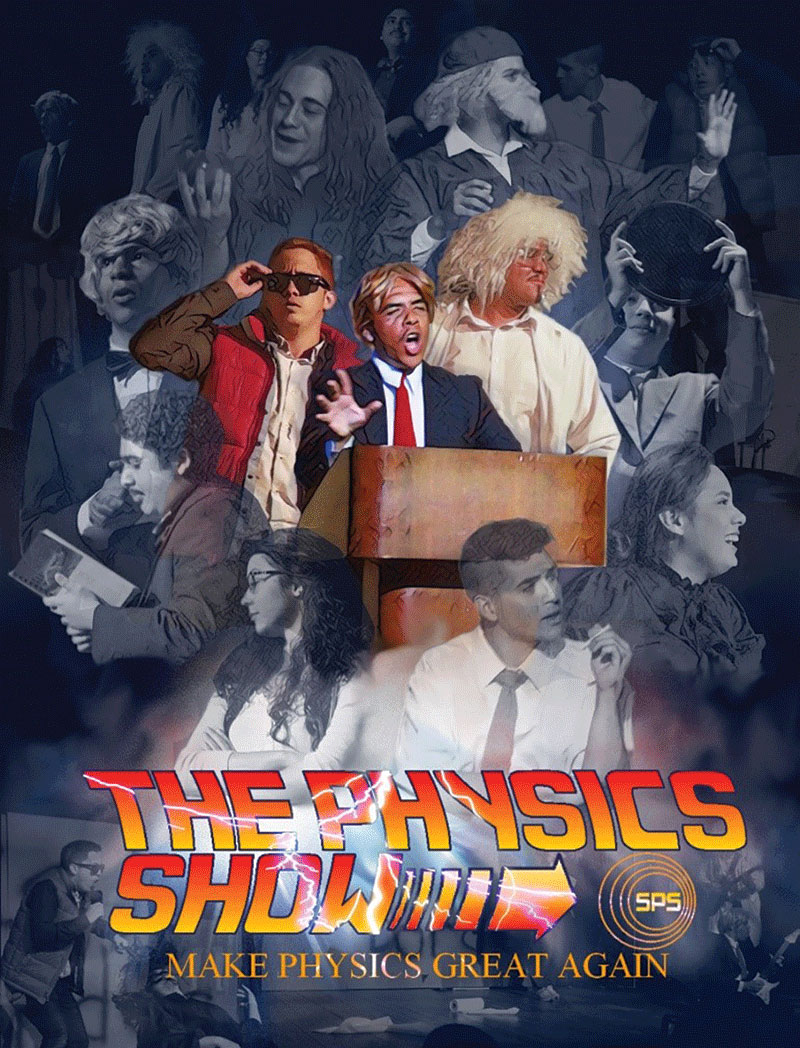The Physics Show: WHEN SCIENCE AND PERFORMANCE COME TOGETHER
Winter
2020
Feature
The Physics Show: WHEN SCIENCE AND PERFORMANCE COME TOGETHER
Christian Nieves, SPS Member, University of Puerto Rico, Mayagüez Campus
 Two time travelers join forces with the president of the United States to visit some of history’s greatest scientists and help them save the world from an imminent catastrophe . . . Sounds crazy, right? Well, that’s the plot of “The Physics Show: Make Physics Great Again,” which we presented three times for the students and faculty at University of Puerto Rico at Mayagüez during the Spring 2019 semester.
Two time travelers join forces with the president of the United States to visit some of history’s greatest scientists and help them save the world from an imminent catastrophe . . . Sounds crazy, right? Well, that’s the plot of “The Physics Show: Make Physics Great Again,” which we presented three times for the students and faculty at University of Puerto Rico at Mayagüez during the Spring 2019 semester.
When Manuel Lozano, the newly elected president of the SPS UPRM chapter, approached me in 2017 with the idea of making a physics show, it did seem a bit far-fetched. Originally, the idea was to do something similar to what two of our professors, Dr. Erick Roura and Dr. Pablo Marrero, did while they were members of SPS in the 1990s—perform entertaining physical science demonstrations for an audience. But we wanted to spice things up, add a bit of theatricality. However, after Hurricane María the show kept getting delayed, which allowed the concept to slowly evolve. What started as a straightforward presentation ended up as a full theatrical play with a 70-page script. I knew it was probably a bad idea to write such a long play, but at the same time, Manuel and I knew we were creating something people had never seen before. Why not give it a try?
We wanted to expose the audience to a little bit of the history of physics and its evolution. In the play, our time travelers go back to 1693, 1860, 1911, and 1953. They visit well-known scientists like Newton, Galileo, and Einstein, and others not so well known by the general public, such as Marie Curie, Michael Faraday, and J. Robert Oppenheimer. Each scene explores a different area of physics—classical mechanics, electromagnetism, and relativity (with a bit of quantum mechanics). We also wanted to highlight the struggle women have historically encountered to gain recognition for their work in physics.
Once we had a good story, we had to find the right people. There were no auditions. Instead, we looked for people excited about science throughout our campus. We ended up with nine physicists, three mechanical engineers, a mathematician, and two English majors. Most didn’t have any acting experience. We rehearsed once or twice a week for six months. It was important to me that the actors had great chemistry and were familiar with the physical concepts that were being demonstrated. As we all know, things often go wrong during physics demonstrations, and if they did, we wanted the actors to feel comfortable enough to know what to do without breaking from their roles.
The play was almost two hours long. By drawing on theatre, film, and music courses as well as the talents of our team members, we filled the show with unique elements to engage the audience—video, sound effects, comedy, original music, and audience participation. We even wrote and recorded a four-minute theme song that, although it may not win any Grammy Awards, provided a fun ending to our show. Arguably the most exciting element of our show was the comedy. When developing the script, I knew I had to be careful to use jokes that everybody could understand, something that can be hard for physicists. At the end of the day, we wanted the show to be something unexpected, and judging by the reaction of the audience, we were successful.
So, why would physics students spend so much time making a play about physics? For many years, I’ve seen physics students slowly distance themselves from nonscientific people. But at some point in all of our lives, there was a moment when we saw something or someone that inspired us to study physics and made us think, “This is what I want for me!” We made “The Physics Show” to be that inspiration. Science is not only for scientists just as art is not only for artists. Mixing science with performance allowed us to break that silly barrier and, more importantly, helped us share knowledge with others as we learned a little bit ourselves.




